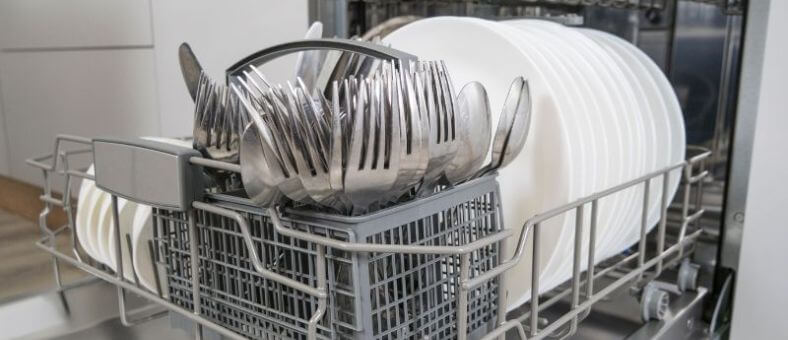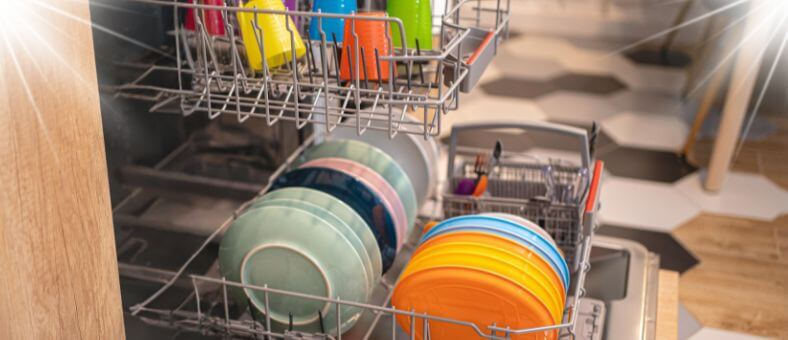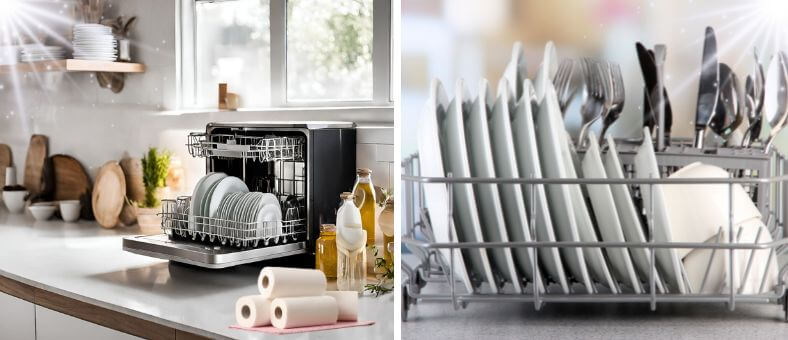Are you tired of finding leftover food on your dishes even after a wash cycle? If so, this guide on ‘How to Load Your Dishwasher Properly’ is just for you! While loading a dishwasher may seem straightforward, doing it correctly can significantly impact it. When done right, your dishes come out spotless, the machine lasts longer, and you can save energy. In fact, it’s like a game – you have to know where each piece goes to win the best results.
So, are you ready to make dirty dishes a thing of the past and become a master of your dishwasher? Keep reading this simple, friendly guide. Together, we’ll unlock the full potential of your dishwasher and say goodbye to those annoying food bits forever!
Table of Contents
Sensors Galore!
Modern dishwashers often have sensors that detect how dirty the dishes are, adjusting the wash cycle accordingly.
Understanding the Top Rack Better
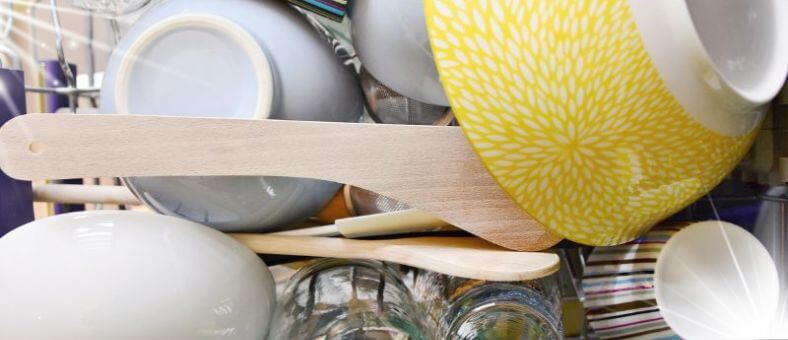
The top rack of your dishwasher is the ideal sanctuary for particular items. Cups, glasses, and smaller bowls find their place here, but positioning is key. Arrange these items upside down and between the tines rather than on top of them. This way, they are less likely to jostle around during the wash cycle, leading to cleaner dishes and reduced accidental chipping.
Plastic containers also belong on the top rack. The heat source in most dishwashers is situated at the bottom, so the top rack is more remarkable, which means your plastic items are less likely to warp or melt. However, always check if your plastics are dishwasher safe before popping them in.
When you come across a mug or cup with a stubborn tea or coffee stain, give it a VIP seat towards the center of the top rack. This position exposes it to the most forceful water spray, which can help shift those pesky stains.
And don’t forget about your delicate wine glasses! Place them carefully between the tines, ensuring they’re secure. If your dishwasher has a stemware holder or a fold-down rack, use them to keep your wine glasses stable and protected.
Getting to Know Your Bottom Rack Better

Now let’s conquer the realm of the bottom rack. Think of this as the sturdy gladiator of your dishwasher – a place for heavier, bulkier items such as dinner plates, serving dishes, and more giant bowls. However, this does not imply that you can throw them carelessly. There’s a strategy for the bottom rack too.
Arrange your plates and more oversized flat items in the slots provided, facing the center. The water spray in dishwashers usually emanates from the middle, reaching the sides evenly, so aligning items this way ensures they’ll all get an equal share of the cleaning action.
When you have large pots, pans, and casseroles, angle them downward, allowing water to access the inside. This will improve their cleanliness, making your post-meal clean-up so much easier.
Your cutlery also belongs on the bottom rack. For safety reasons, knives should be placed with the sharp end downwards. Other utensils like spoons and forks should face upwards so the water can access the food-soiled parts more easily. Mix spoons and forks to prevent them from nesting together – they may enjoy the cuddle, but it won’t get them clean!
Making the Most of the Third Rack
If your dishwasher features the exclusive third rack, let’s decode its optimal use. Typically more shallow than the other two, this rack is intended for longer, flatter utensils and smaller items.
This is the perfect place for spatulas, whisks, serving spoons, and other cooking tools. Their length fits nicely in this shallow space, and their flat shape allows them to lie securely without interfering with the water spray.
The third rack is also a safe zone for smaller items that could get lost or tossed around in a regular wash cycle. Think of small lids, baby bottle parts, or cups from your espresso machine. With everything neatly laid out on the third rack, each item will get the attention it needs.
The Third Rack’s Magic!
The third rack, often found in newer models, increases loading capacity by about 30%, making room for more dishes!
Concluding Thoughts on How to Load Your Dishwasher Properly
Alright, rockstars, ready for some mind-blowing dish magic? By using these super-cool loading tricks, your dishwasher will work harder for you and zap every last bit of grime from your dishes. But remember, brush off those big chunks of food before you load up. And don’t cram everything in – a packed dishwasher won’t clean your dishes well.
You’re stepping up your dishwashing game by being a smart loader and following these easy-peasy guidelines! No more annoying re-washes – just dazzlingly clean dishes every single time. Here’s to less tedious chores and more time enjoying the sparkle of perfectly clean dishes. Let’s make cleaning fun, champions!
Additional Tips for Loading a Dishwasher
Alright, eager learners, now that you’ve mastered the basics of loading a dishwasher, it’s time to add some extra flavors to your dishwashing recipe. Let’s sprinkle in some more tips and tricks to ensure your dishwasher performs at its best. This is where we delve deeper, add nuances, and navigate the dishwasher-loading journey with an expert eye.
Pre-rinsing Dishes: Myth or Necessity?
One of the most widespread dishwasher misconceptions involves pre-rinsing. Many believe dishes must be thoroughly rinsed before entering the dishwasher. This is, however, unnecessary in most cases. Modern dishwashers are designed to handle everyday food residue without requiring a pre-rinse.
Not only does pre-rinsing wastewater and time, but it can also lead to less efficient cleaning. Many contemporary dishwasher models use sensors to detect food particles. These sensors then adjust the wash cycle to ensure optimal cleaning. By pre-rinsing, you could be tricking your dishwasher into thinking your dishes are cleaner than they are, resulting in a less effective wash.
Secure Small Items: Prevent Slipping
Every household has tiny titans – small items such as bottle caps, corn cob holders, or baby’s pacifiers. These items may get lost or fall through the racks during a wash cycle, potentially damaging your dishwasher.
Consider placing these smaller items in a dishwasher-safe mesh bag or a specially designed basket to prevent this. Not only does this keep them secure during the wash, but it also makes them easier to find when unloading.
Determining How Much Detergent is Right
Too much of a good thing can lead to harm; this adage also holds true for dishwasher detergent. Overloading on detergent can leave an unsightly soap residue on your dishes, making them less clean and shiny.
Measuring your detergent according to the manufacturer’s instructions and adjusting the amount based on your water hardness and the load’s soil level is essential. And remember, detergent isn’t wine—it doesn’t get better with age. Over time, detergent can degrade and lose its effectiveness. So, buy smaller quantities you’ll use up within a few months.
A Sneak Peek Into the Past
Dishwasher detergents debuted in the market around the mid-20th century, making dishwashing easier and quicker!
Dishwasher Timing: When to Run It for Best Results
Perhaps you haven’t thought about it previously. Still, the timing of your dishwasher cycles can impact your utility bills and the lifespan of your dishwasher. Running your dishwasher during off-peak hours, typically during the nighttime, can sometimes help you take advantage of lower energy rates. Plus, there’s something immensely satisfying about waking up to a dishwasher full of sparkling clean dishes!
Regular Maintenance: Key to a Long-Lasting Dishwasher
Just like any other appliance in your home, your dishwasher requires proper maintenance to ensure it runs efficiently. Make it a monthly routine to clean your dishwasher filter. Removing accumulated food particles can significantly improve its performance.
It’s a good idea to occasionally run an empty dishwasher cycle with a specialized cleaner. This can help keep your dishwasher in good condition. This can help remove mineral buildup from the dishwasher’s inner mechanisms, improving its efficiency and lifespan.
Dish Size: Key for Dishwasher Buying
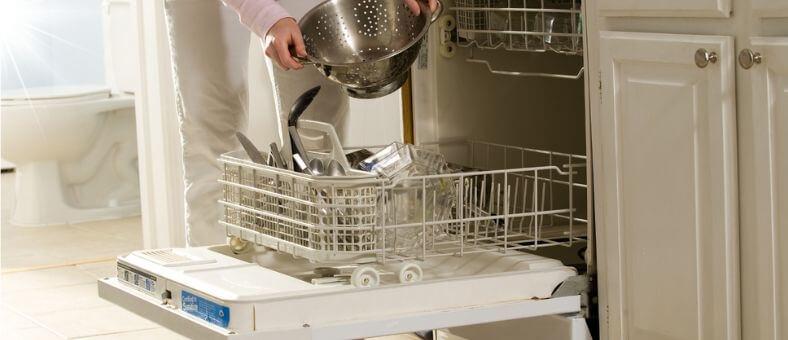
Have you ever bought a large cutting board, a beautiful baking sheet, or a large colander, only to realize they don’t fit in your dishwasher? Avoid such disappointments by considering your dishwasher’s dimensions when shopping for kitchenware. If it doesn’t fit, you’ll be stuck with the tedious task of hand washing.
Resisting Overload: Find the Right Fit
While squeezing in that last dish might be satisfying, resist the urge. Overloading your dishwasher impedes the water and detergent from circulating effectively, which can lead to fewer clean dishes. It’s best to think of your dishwasher like a jigsaw puzzle, where every piece has its place, rather than a game of Tetris where the goal is to fit as many pieces as possible.
The journey to master dishwasher loading is ongoing. By following these tips, you will achieve cleaner dishes and help prolong your dishwasher’s life. Remember, your dishwasher is there to simplify your life, not complicate it. So treat it right, and it will reward you with stellar service.
Dishwasher Magic: More Sparkle, Less Hassle!
Wow, who knew dishwashers had so many tricks up their sleeves? We bet you’re ready to put all this incredible new knowledge to work! By using these additional tips for loading your dishwasher, your dishes will sparkle like never before. Plus, you’ll be taking super good care of your dishwasher, ensuring it sticks around to clean up after your meals for a long time. So, get ready to impress everyone at home with your dishwasher skills! There’ll be less time for cleaning and more time for fun. Let’s make those chores easier and turn a tedious task into an exciting game. Dishwasher, here we come!
At WashDryDazzle, our primary goal is to equip you with invaluable knowledge to simplify your day-to-day tasks; to explore more, check out our central hub of Dishwasher Guides.
Frequently Asked Questions (FAQs)
Why does the position of dishes in the dishwasher matter?
Positioning matters because it allows optimal water flow and better cleaning. Each item must be exposed to the dishwasher’s water jets to get cleaned properly.
Can I put pots and pans in the dishwasher?
This depends on the manufacturer’s instructions for your pots and pans. Some are dishwasher safe, while others recommend hand washing. Check the instructions before loading.
How often should I clean the dishwasher itself?
It’s a good practice to clean your dishwasher once a month. This will help remove accumulated food particles and keep your dishwasher running smoothly.
Can I mix silverware in the dishwasher?
Yes, it’s recommended to mix forks, spoons, and knives to prevent them from nesting and ensure they get cleaned effectively.
Should I always load the dishwasher to full capacity before running a cycle?
While running a full load is energy efficient, you should avoid overloading. This could hinder the dishwasher’s performance and lead to poorly cleaned dishes.

